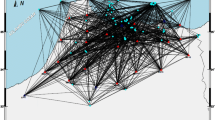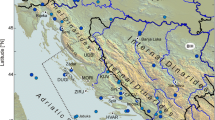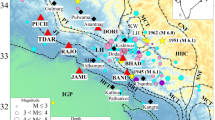Abstract
We investigate the frequency-dependent seismic attenuation characteristics of the crust beneath Kumaun Himalaya, India, using seismic coda waves (Qc−1) and high-frequency body waves (Qα−1 and Qβ−1). We used about 300 local earthquakes, well-recorded by 32 three-component broadband stations, for characterizing the seismic attenuation. The corresponding geodynamic implications are analyzed for the entire study region and for major tectonic segments such as the Lesser Himalaya (LH) and the Higher Himalaya (HH). The coda quality factor, Qc, computed from the single backscattering model, shows a dependence on both frequency (1–20 Hz) and lapse times (20–50 s). Expressed as power laws (Qc = Q0fn), Q0 (Q at 1 Hz) and n (frequency-dependence exponent) vary as 320 and 0.78 for lapse time window (LTW) 20 s to 656 and 0.55 at LTW 50 s. Similarly, the Q factor of body waves (Qα and Qβ), computed using the coda normalization and extended coda normalization methods (Yoshimoto et al. Geophys J Int 114: 165–174, 1993), also show strong frequency dependence. They are expressed as Qα = (36.28 ± 0.05)f(0.85±0.01) and Qβ = (50.58 ± 0.15)f(0.94±0.01). The ratio Qβ/Qα is found to be larger than unity in the whole frequency range for the entire study region. This observation is interpreted as an effect from seismically active regions and heterogeneous crustal regimes. Additionally, to characterize the dominant attenuation mechanism, we separate the quality factors for intrinsic attenuation (Qi−1) and scattering attenuation (Qs−1), using the Wennerberg (Bull Seismol Soc Am 83:279–290, 1993) formulation. Our study shows that the seismic attenuations are different for the LH and the HH segments. This possibly is due to the mechanism of underthrusting and deformation in the LH segments, leading to a dominant scattering attenuation and the multitude of fractures and pores in the crust. Our study shows that (1) Qc−1 is less than Qβ−1, which seems to adhere to Zeng’s (J Geophys Res 96:607–619, 1991) theory; (2) Qc−1 is closer to Qi−1; (3) the ratio (Qα−1/Qβ−1) lies between 1.7 and 2.25. The results are in agreement with several theoretical and laboratory experiments and suggest heterogenous crustal media. The varying attenuation characteristics, seismic energy budget and radiating efficiency have a significant role in seismic hazard analysis in Kumaun Himalaya.


















Similar content being viewed by others
Availability of Data and Material
Data are available upon request to the Director, CSIR-NGRI.
References
Aki, K. (1969). Analysis of the seismic coda of local earthquakes as scattered waves. Journal of Geophysical Research, 74(2), 615–631.
Aki, K. (1980). Scattering and attenuation of shear waves in lithosphere. Journal of Geophysical Research, 85, 6496–6504.
Aki, K., & Chouet, B. (1975). Origin of coda waves; source, attenuation and scattering effects. Journal of Geophysical Research, 80, 3322–3342.
Akinci, A., Del Pezzo, E., & Ibanez, J. M. (1995). Separation of scattering and intrinsic attenuation in southern Spain and western Anatolia (Turkey). Geophysical Journal International, 121, 337–353.
Akinci, A., Del Pezzo, E., & Malagnini, L. (2020). Intrinsic and scattering seismic wave attenuation in the Central Apennines (Italy). Physics of the Earth and Planetary Interiors, 303, 106498. https://doi.org/10.1016/j.pepi.2020.106498
Akinci, A., & Eyidogan, H. (1996). Frequency-dependent attenuation of S and coda waves in Erzincan region (Turkey). Physics of the Earth and Planetary Interiors, 97, 109–119.
Ashish, P. A., Rai, S. S., & Gupta, S. (2009). Seismological evidence for shallow crustal melt beneath the Garhwal High Himalaya, India: Implications for Himalayan channel flow. Geophysical Journal International, 177(1), 1111–1120.
Bianco, F., Del Pezzo, E., Castellano, M., Ibanez, J., & Di Luccio, F. (2002). Separation of intrinsic and scattering seismic attenuation in the Southern Apennine zone, Italy. Geophysics Journal International, 150, 10–22.
Bilham, R., Larson, K., & Freymueller, J. (1997). GPS measurements of present day convergence across the Nepal Himalaya. Nature, 386, 61–64.
Burchfiel, C., Zhiliag, C., Hodges, K. V., Yuping, L., Royden, L., Changrong, D., & Jiene, X. (1992). The south Tibetan detachment system, Himalayan orogen: Extension contemporaneous with and parallel to shortening in a collisional mountain belt. Special Paper Geology Society of America, 269, 41.
Burg, J. P., & Chen, G. M. (1984). Tectonics and structural zonation of southern Tibet. Nature, 311, 219–223.
Canas, J. A., Ugalde, A., Pujades, L. G., Carracedo, J. C., Soler, V., & Blanco, M. J. (1998). Intrinsic and scattering seismic wave attenuation in the Canary Islands. Journal of Geophysical Research, 103(15037–15), 050.
Castro, R. R., Pacor, F., & Spallarossa, D. (2021). Depth-dependent shear-wave attenuation in central Apennines, Italy. Pure Applied Geophysics, 178, 2059–2075. https://doi.org/10.1007/s00024-021-02744-9
Chung, T. W., & Sato, H. (2001). Attenuation of high frequency P and S waves in the crust of southeastern South Korea. Bulletin of the Seismological Society of America, 91, 1867–1874.
Dainty, A. M. (1981). A scattering model to explain seismic Q observations in the lithosphere between 1 and 30 Hz. Geophysical Research Letters, 8, 1126–1128.
Del Pezzo, E., Giampiccolo, E., Tuvé, T., Di Grazia, G., Gresta, S., & Ibàñez, J. M. (2019). Study of the regional pattern of intrinsic and scattering seismic attenuation in Eastern Sicily (Italy) from local earthquakes. Geophysical Journal International, 218(2), 1456–1468. https://doi.org/10.1093/gji/ggz208
Del Pezzo, E., Ibanez, J., Morales, J., Akinci, A., & Maresca, R. (1995). Measurements of intrinsic and scattering seismic attenuation in the crust. Bull Seismology Society of America, 85, 1373–1380.
Fehler, M., Hoshiba, M., Sato, H., & Obara, K. (1992). Separation of scattering and intrinsic attenuation for the Kanto-Tokai region, Japan, using measurements of S-wave energy vs hypocentral distance. Geophysics Journal International, 108, 787–800.
Frankel, A. (1991). Mechanisms of Seismic Attenuation in the Crust: Scattering and anelasticity in New York State, South Africa, and Southern California. Journal of Geophysics Research, 96, 6269–6289.
Frankel, A., McGarr, A., Bicknell, J., Mori, J., Seeber, L., & Cranswick, E. (1990). Attenuation of high- frequency shear waves in the crust: Measurements from New York State, South Africa, and Southern California. Journal of Geophysical Research, 95, 17441–17457.
Frankel, A., & Wennerberg, L. (1987). Energy flux model of seismic coda: Separation of scattering and intrinsic attenuation. Bulletin Seismology Society of America, 77, 1223–1251.
Gao, L. S., Lee, L. C., Biswas, N. N., & Aki, K. (1983). Comparison of the effects between single and multiple scattering on coda waves for local earthquakes. Bulletin of the Seismological Society of America, 73, 377–389.
Giampiccolo, E., Gresta, S., & Rasconà, F. (2004). Intrinsic and scattering attenuation from observed seismic codas in southeastern Sicily (Italy). Physics Earth Planet International, 145, 55–66.
Giampiccolo, E., Tusa, G., Langer, H., & Gresta, S. (2002). Attenuation in southeastern Sicily (Italy) by applying different coda methods. Journal of Seismology, 6, 487–501.
Gupta, S., Mahesh, P., Nagaraju, K., Sivaram, K., & Paul, A. (2022). 3-D seismic velocity structure of the Kumaun-Garhwal (Central) Himalaya: Insight into the Main Himalayan Thrust and earthquake occurrence. Geophysical Journal International, 229(1), 138–149. https://doi.org/10.1093/gji/ggab449
Gusev, A. A., & Abubakirov, I. R. (1987). Monte-Carlo simulation of record envelope of a near earthquake. Physics of the Earth and Planetary Interiors, 49, 30–36.
Hazarika, P., Kumar, M. R., & Kumar, D. (2013). Attenuation character of seismic waves in Sikkim Himalaya. Geophysical Journal International, 195, 544–557.
Ibanez, J. M., Del Pezzo, E., De Miguel, F., Herraiz, M., Alguaicil, G., & Morales, J. (1990). Depth dependent seismic attenuation in the Granada zone (southern Spain). Bulletin of the Seismological Society of America, 80, 1232–1244.
Iqbal, M. Z., Chung, T. W., Nam, M. J., & Yoshimoto, K. (2021). Temporal variation in scattering and intrinsic attenuation due to earthquakes in East Asia. Science and Reports, 11, 11260. https://doi.org/10.1038/s41598-021-90781-8
Jackson, I., Fitzgerald, J. D., Faul, U. H., & Tan, B. H. (2002). Grain-size-sensitive seismic wave attenuation in polycrystalline olivine. Journal of Geophysics Research, 107, ECV5.
Jin, A., & Aki, K. (1989). Spatial and temporal correlation between coda Q−1 and seismicity and its physical mechanism. Journal of Geophysics Research, 94, 14041–14059.
Knopoff, L. (1964). Q. Rev Geophysics, 2, 625–660.
Kumar, N., Parvez, I. A., & Virk, H. S. (2005). Estimation of coda wave attenuation for NW Himalayan region using local earthquakes. Physics of the Earth and Planetary Interiors, 151, 243–258. https://doi.org/10.1016/j.pepi.2005.03.010
Larson, K. M., Burgmann, R., & Bilham, R. (1999). Freymueller JT (1999) Kinematics of the India-Eurasia collision zone from GPS measurements. Journal of Geophysical Research, 104, 1077–1093.
Le Fort, P. (1996). Evolution of the Himalaya. In A. Yin & M. Harrison (Eds.), The tectonic evolution of Asia (pp. 95–109). Press.
Le Fort, P., Cuney, M., Deniel, C., France-Lanord, C., Sheppard, S. M. F., Upreti, B. N., & Vidal, P. (1987). Crustal generation of the Himalayan leucogranites. Tectonophysics, 134, 39–57.
Ma, X., & Huang, Z. (2020). Attenuation of high-frequency P and S waves in the crust of Central and Western Tien Shan. Pure Applied Geophysics, 177, 4127–4142. https://doi.org/10.1007/s00024-020-02504-11
Mahesh, P., Gupta, S., Rai, S. S., & Sarma, P. R. (2012). Fluid driven earthquakes in the Chamoli Region, Garhwal Himalaya: Evidence from local earthquake tomography. Geophysical Journal International, 191, 1295–1304.
Mahesh, P., Rai, S. S., Sivaram, K., Paul, A., Gupta, S., Sarma, P. R., & Gaur, V. K. (2013). One dimensional reference velocity model and precise locations of earthquake hypocenters in the Kumaon-Garhwal Himalaya. Bulletin Seismology Society of America, 103, 328–339.
Mahood, M., Hamzehloo, H., & Doloei, G. J. (2009). Attenuation of high frequency P and S waves in the crust of the East-Central Iran. Geophysical Journal International, 179, 1669–1678.
Matsumoto, S., & Hasegawa, A. (1989). Two-dimensional coda Q structure beneath Tohoku, NE Japan. Geophysics Journal International, 99, 101–108.
Mayeda, K., Koyanagi, S., Hoshiba, M., Aki, K., & Zeng, Y. (1992). A comparative study of scattering, intrinsic and coda Q- ’ for Hawaii, Long Valley, and Central California between 1.5 and 15 Hz. Journal of Geophysical Research, 97, 6661–6674.
Mishra, O. P., Vandana, V. K., & Gera, S. K. (2020). A new insight into seismic attenuation characteristics of Northwest Himalaya and its surrounding region: Implications to structural heterogeneities and earthquake hazards. Physics of the Earth and Planetary Interiors, 306(106500), 0031–9201. https://doi.org/10.1016/j.pepi.2020.106500
Mitchell, B. J. (1981). Regional variation and frequency dependence of Q in the crust of the United States. Bulletin of the Seismological Society of America, 71, 1531–1538.
Mitchell, B. J. (1995). Anelastic structure and evolution of the continental crust and upper mantle from seismic surface wave attenuation. Revision Geophysics, 33(4), 441–462.
Molnar, P., England, P., & Martinod, J. (1993). Mantle dynamics, the uplift of the Tibetan Plateau, and the Indian monsoon. Reviews of Geophysics, 31, 357–396.
Monika., Kumar, P., Sandeep., Kumar, S., Joshi, A., & Devi, S. (2020). Spatial variability studies of attenuation characteristics of Qα and Qβ in Kumaon and Garhwal region of NW Himalaya. Natural Hazards, 103, 1219–1237. https://doi.org/10.1007/s11069-020-04031-7
Mukhopadhyay, S., & Sharma, J. (2010). Attenuation characteristics of Garwhal-Kumaun Himalayas from analysis of coda of local earthquakes. Journal of Seismology, 14(4), 693–713.
Mukhopadhyay, S., Sharma, J., Del-Pezzo, E., & Kumar, N. (2010). Study of attenuation mechanism for Garwhal-Kumaun Himalayas from analysis of coda of local earthquakes. Physics of the Earth and Planetary Interiors, 180, 7–15.
Mukhopadhyay, S., Tyagi, C., & Rai, S. S. (2006). The Attenuation mechanism of seismic waves in northwestern Himalayas. Geophysical Journal International, 167, 354–360.
Ni, J., & Barazangi, M. (1984). Seismotectonics of the Himalayan collision zone: Geometry of the underthrusting Indian plate beneath the Himalayas. Journal of Geophysical Research, 89, 1147–1163.
Padhy, S., & Subhadra, N. (2013). Separation of intrinsic and scattering seismic wave attenuation in Northeast India. Geophysical Journal International, 195, 1892–1903.
Padhy, S., Subhadra, N., & Kayal, J. R. (2011). Frequency-dependent attenuation of body and coda waves in the Andaman Sea basin. Bulletin of the Seismological Society of America, 101(1), 109–125. https://doi.org/10.1785/0120100032
Patane, D., Ferrucci, F., & Gresta, S. (1994). Spectral features of microearthquakes in volcanic areas: attenuation in the crust and amplitude response of the site at Mt. Etna, Italy. Bulletin Seismology Society of America, 84, 1842–1860.
Paul, A., Gupta, S. C., & Pant, C. (2003). Coda Q estimates for Kumaun Himalaya. Proceedings Indian Academy Science (earth Planetary Science), 112, 569–576.
Pulli, J. J. (1984). Attenuation of coda waves in New England. Bulletin of the Seismological Society of America, 74, 1149–1166.
Pulli, J. J., & Aki, K. (1981). Attenuation of seismic waves in the lithosphere: Comparison of active and stable areas. In J. E. Beavers (Ed.), Earthquakes and Earthquake Engineering: The Eastern US (pp. 129–141). Ann Arbor Science Publishers.
Rautian, T. G., & Khalturin, V. I. (1978). The use of coda for determination of the earthquake source spectrum. Bulletin of the Seismological Society of America, 68, 923–948.
Roecker, S. W., Tucker, B., King, J., & Hartzfield, D. (1982). Estimates of Q in Central Asia as a function of frequency and depth using the coda of locally recorded earthquakes. Bulletin of the Seismological Society of America, 72, 129–149.
Sato, H. (1978). Mean free path of S-waves under the Kanto district of Japan. Journal of Physics of the Earth, 26(2), 185–198.
Sato, H. (1982). Attenuation of S-waves in the lithosphere due to scattering by its random velocity structure. Journal of Physics of the Earth, 87, 7779–7785.
Sato, H., & Fehler, M. (1998). Seismic wave propagation and scattering in the heterogeneous earth (Vol. 308, p. 319). Springer.
Searle MP (1991) Geology and Tectonics of the Karakoram Mountains. John Wiley & Sons, Chichester, with Geological Map of the Central Karakoram, scale 1:250,000. Department Earth Sciences, University of Oxford, Oxford.
Seeber L, Armbruster J (1981) Great detachment earthquakes along the Himalayan are and long-term forecasting I Earthquake Prediction. An International Review D.W Simpson, P.G. Richards (Eds.), Am Gcophys Union. Maurice Ewing Ser., 4:254–279
Shang, T., & Gao, L. (1988). Transportation theory of multiple scattering and its application to seismic coda waves of impulse source. Sci Sinica Ser. B, 31, 1503–1514.
Sharma, B., Gupta, A. K., Kameswari Devi, D., Kumar, D., Teotia, S. S., & Rastogi, B. K. (2008). Attenuation of high-frequency seismic waves in Kachchh Region, Gujarat, India. Bulletin of the Seismological Society of America, 98(5), 2325–2340. https://doi.org/10.1785/0120070224
Sheehan, A. F., de la Torre, T. L., Monsalve, G., Abers, G. A., & Hacker, B. R. (2014). Physical state of himalayan crust and uppermost mantle: Constraints from seismic attenuation and velocity tomography. J Geophys Res: Solid Earth, 119(1), 567–580. https://doi.org/10.1002/2013JB010601
Singh, C., Bharathi, V. S., & Chadha, R. (2012). Lapse time and frequency-dependent attenuation characteristics of Kumaun Himalaya. Journal of Asian Earth Sciences, 54, 64–71.
Singh, S., & Herrmann, R. B. (1983). Regionalization of crustal coda Q in the continental United States. J Geophys Res Solid Earth, 88(B1), 527–538.
Tapponnier P, Peltzer G, Armijo R (986) On the mechanics of the collision between India and Asia, in Collision Tectonics, Geological Society of London Special Publication, pp. 115–157, eds Coward M.P. Ries A.C.
Tripathi, J. N., Singh, P., & Sharma, M. (2014). Attenuation of high-frequency P- and S-waves in Garhwal Himalaya, India. Tectonophysics, 636, 216–227. https://doi.org/10.1016/j.tecto.2014.08.015
Vassiliou M, Salvado CA, Tittman BR (1982) Seismic attenuation, in CRC Handbook of Physical Properties of Rocks, R. S. Carmichael (Editor), 3, CRC Press, Boca Raton, Florida
Wennerberg, L. (1993). Multiple-scattering interpretations of coda-Q measurements. Bulletin of the Seismological Society of America, 83, 279–290.
Winkler, K. W., & Nur, A. (1982). Seismic attenuation: Effects of pore fluids and frictional sliding. Geophysics, 47, 1–15.
Yoshimoto, K. H., Sato, H., & Ohtake, M. (1993). Frequency dependent attenuation of P and S waves in the Kanto area, Japan, Based on the Coda Normalization Method. Geophysics Journal International, 114, 165–174.
Zeng, Y., Su, F., & Aki, K. (1991). Scattered wave energy propagation in a random isotropic scattering medium, I, theory. Journal of Geophysical Research, 96, 607–619.
Acknowledgements
The authors thank CSIR-NGRI for granting permission to publish this work. Author (SK) gratefully acknowledges the early guidance of Dr. Dinesh Kumar in the computation of seismic attenuation. All the field members of the seismological field in Kumaun-Garhwal Himalaya are duly acknowledged for their hard work and data acquisition. We acknowledge the support under CSIR-NGRI projects SHIVA [MLP0001-28-FBR-1] and ProbHim [MLP-FBR-003]. The authors sincerely acknowledge the Editor, Dr Yangfan Deng, and the three anonymous reviewers whose suggestions have significantly improved the manuscript. The CSIR-NGRI reference number of the manuscript is NGRI/Lib/2022/ Pub-09.
Funding
CSIR NGRI.
Author information
Authors and Affiliations
Contributions
KS: Conceptualization, data curation, visualization, methodology, writing—original draft preparation, reviewing and editing. SG: Visualization, writing—reviewing and editing.
Corresponding author
Ethics declarations
Conflicts of interest
The authors declare no competing interests.
Additional information
Publisher's Note
Springer Nature remains neutral with regard to jurisdictional claims in published maps and institutional affiliations.
Rights and permissions
About this article
Cite this article
Sivaram, K., Gupta, S. Frequency-Dependent Attenuation Characteristics of Coda and Body Waves in the Kumaun Himalaya: Implications for Regional Geology and Seismic Hazards. Pure Appl. Geophys. 179, 949–972 (2022). https://doi.org/10.1007/s00024-022-02963-8
Received:
Revised:
Accepted:
Published:
Issue Date:
DOI: https://doi.org/10.1007/s00024-022-02963-8




